Emerald Fennell’s playful psychological thriller Saltburn offers a subversive twist on the English country-house drama. The filmmaker tells Screen about exploring intense desire and the reality of impossible beauty.
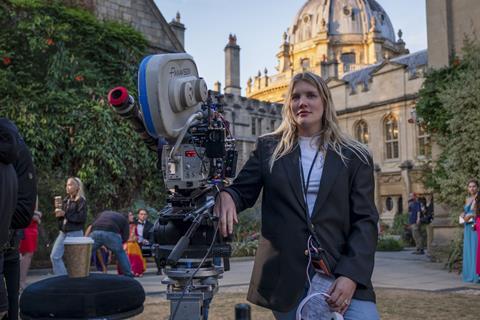
For Emerald Fennell, Saltburn all started with the lick of a bathtub plughole. “A film idea usually starts with me as a flash of something visual,” says the writer/director/producer. “This film started seven or eight years ago with an image of someone licking the bottom of the bathtub. You know everything from that image — that’s about somebody wanting something they can’t have. When we’re in the grip of a really intense desire, I don’t think licking the bottom of the bathtub feels that transgressive. Desire is not all candles and jazz, it can be more sinister.”
Indeed, this scene makes it into the final film of Saltburn — but this article will not spoil exactly who is licking, when or why.
The story follows Oliver Quick (Barry Keoghan) as he struggles to fit in at the University of Oxford, before he is drawn into the world of the popular and charming Felix Catton (Jacob Elordi). Felix feels sorry for Oliver and invites him to his family’s sprawling estate, Saltburn, where Oliver has an unforgettable summer in 2007 with Felix’s mother Elspeth (Rosamund Pike), father Sir James (Richard E Grant), sister Venetia (Alison Oliver), cousin Farleigh (Archie Madekwe) and eccentric family friend Pamela (Carey Mulligan, who also starred in the director’s 2020 debut feature Promising Young Woman).
After the bathtub image, Fennell says she developed the plot over “years and years” in her head before finally writing the script. “Once I do it on paper, it has the most minimal redrafting. It’s kind of lived in my head for four or five years. By the time it gets to the page, it’s almost word-perfect for what’s been said in my head 1,000 times. Obviously you have to redraft, but I try not to do that too much because a story can lose its emotional honesty about the messy business of being a human. I would rather things felt a little stickier and more immediate than they had been smoothed over.”
With twisted psychological thriller Saltburn, Fennell is making her second feature as writer/director — 2020’s Promising Young Woman won her the best original screenplay Oscar and Bafta. She is also an actress who has been seen in projects as diverse as Call The Midwife, The Crown and this year’s megahit Barbie — plus she was a showrunner on season two of Killing Eve, and is a published novelist (one of her books was the basis of Andrew Lloyd Webber’s stage musical Cinderella, aka Bad Cinderella). For both Promising Young Woman and Saltburn, she also serves as producer — in the latter case alongside LuckyChap Entertainment’s Margot Robbie and Josey McNamara. LuckyChap produces Saltburn alongside MRC and Amazon Studios/MGM, with the latter distributing in the US, and Warner Bros handling internationally, following a global launch at Telluride Film Festival.
Behind the enigma

Oliver Quick, for reasons that become clear through the film’s twists and turns, is not a straightforward character to play. “The reason the film starts with the line, ‘I wasn’t in love with him,’ is that Oliver can define what he doesn’t like, what he isn’t,” explains Fennell. “He’s kind of a negative. He’s somebody who hadn’t defined himself yet. He knew what he wanted to be but not how to be that.
“What his peculiar gift is, is recognising what people need and want, and giving it to them. But what he needs and wants isn’t something that even he could describe. So he’s always chasing something that’s never going to be possible. It’s a difficult one with a character like that, he is enigmatic.”
Fennell always had Irish actor Barry Keoghan in mind for her enigma — even before his Oscar-nominated and Bafta-winning role in The Banshees Of Inisherin, she had been a fan of his performance in Yorgos Lanthimos’s The Killing Of A Sacred Deer. “With Barry, he’s looking for an immediate emotional response. He doesn’t like to rehearse, he wants it to feel immediate and natural. Everything that he’s thinking can be quite clear.”
The actor’s physicality was also important in a pivotal dance sequence that Oliver performs solo at the end of the film. Keoghan’s boxing background came in handy for that. “Polly Bennett is an incredible movement coach and she used some steps that were almost like boxing moves,” says Fennell. “For choreography of any kind, it needs to feel precise and beautiful, but somehow it needs to also be authentic and not feel overly choreographed. It had to feel natural.
“Barry is an absolutely exquisite dancer,” she continues. “He’s an incredibly gifted physical actor. So much of Barry’s power is also how he can be with stillness. He has to be the person at the centre of this film, where in spite of the grand houses and the extreme beauty of the family, this innocuous outsider has the magnetic pole which can hold your attention. Only Barry can do that.”
Working with casting director Kharmel Cochrane, Fennell says the film’s ensemble is exactly as she had hoped. “I can’t think of any other actors that could have done any other part — Jacob has an impossible part [Felix] to do that he does with such cleverness and humour. Alison and Archie as well. It was so important for all of them to understand that if somebody’s arch, if somebody’s cruel, they understood why.”
Fennell cites cinematic references for Saltburn including Bernardo Bertolucci’s The Dreamers and Stealing Beauty and Joe Wright’s Atonement — which share “a hot summer vibe” that she wanted to capture. The Go-Between (1971) and
The Great Gatsby (1974) have ‘innocent bystander’ narrators; Yorgos Lanthimos’s Dogtooth inspired her with its familial isolation; and of course she re-examined period classics such as Merchant Ivory films and ITV’s 1981 TV series Brideshead Revisited, and even the slick teen romance Cruel Intentions.
For the visual style, she knew the audience had to enter these worlds of Oxford and Saltburn, sticking firmly with Oliver’s point of view: “It was always about the constant striving for perfection and the constant disappointment. What we’re doing at every stage is showing the impossible beauty and the fact that it’s disappointing up close.” Key creative collaborators included director of photography Linus Sandgren, editor Victoria Boydell, costume designer Sophie Canale, hair and make-up designer Sian Miller and production designer Suzie Davies.
“At Oxford, we have this incredibly long, complicated tracking shot and Steadicam on a crane,” says Fennell, “but then we see the reality of what the campus is — the common room full of depressed people doing their homework and the room is lit by the vending machines. In Saltburn, it’s like a Caravaggio painting lit by a karaoke machine. It’s human. It’s never ever going to be the perfect thing that somebody is looking for.
“Their bathrooms are so posh they have mahogany furniture, but there are still skidmarks,” she adds with a cheeky laugh. (See sidebar opposite for more on creating the manor of Saltburn.)
Party hard
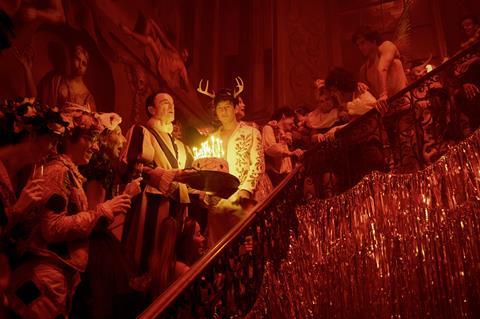
In addition to that complicated opening shot at Oxford, the other major technical challenge of the shoot was the Midsummer Night’s Dream theme party at Saltburn to celebrate Oliver’s birthday. “Parties are so hard to get right,” Fennell says, pointing out her pet peeve of seeing party or nightclub scenes on screen that look immaculate. “I always think, ‘Why is the floor so clear? Why are everyone’s looks so put-together?’”
There were nearly 280 cast members and extras for the party scene. “The costume department and hair and make-up just smashed it,” she praises. To keep the right energy for shooting the party scenes over several night shoots, Fennell was blasting her own playlist of 2007-appropriate bangers that she had curated while writing the script. “It was my own crazy playlist — it even had the Crazy Frog song [‘Axel F’] on it! I wanted to get everyone together and laughing. It was just so much coverage that we needed, so many things to get right, we had to be so comprehensive.”
After Promising Young Woman, Saltburn cements Fennell as a director not afraid to share her bold ideas — whether that is an epic on-screen party or that infamous drain-licking moment. But does she feel brave? “I don’t feel un-brave. I didn’t think Promising Young Woman was brave either… There are things in Saltburn that feel intimate. I’m emotionally and psychologically hyper-gothic, and emotional and unconstrained and metaphorical. And this film lives out of a stew of things that I love. I like working out of specific subgenres where you can see where the seams are that you can start pulling at.”
Fennell is working on new ideas, but will not reveal anything until it is all on paper. She is just thrilled that an image that popped into her head eight years ago has made it all the way to audiences in the way she imagined. “I feel lucky that I can make my films with people who really support and get it. You don’t have to feel brave if you have lots of people standing beside you and doing it themselves because they all have faith in it.”
Finding the perfect Saltburn
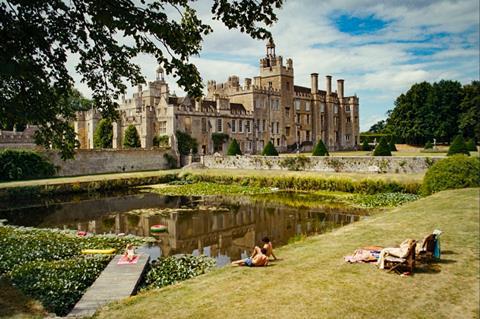
For the Catton family home, Emerald Fennell and her team were determined to find a magnificent manor house in England that had never been seen on screen — a tall order, as many UK estates are either popular shooting locations, carefully protected from filming or been turned into hotels. They found what they were looking for at the second property they visited, on the first day of location visits. “We are contractually not allowed to say where the house is or what the house is — because it had never been filmed in or even photographed before,” Fennell explains. “But I can confirm it is one house, and that helped us so much to get into the mindset. We could feel very much together, everyone eats together at long tables, we work together, we hang out together.”
(Everyone on the production remains tight-lipped about the secret, but society magazine Tatler has outed the location as Drayton House in Lowick, Northamptonshire.)
The real house has its origins in the 1300s with a baroque facade added in the 1700s, and the estate has been with one family since 1066. Fennell was especially impressed with the 17th-century spiral cantilever walnut staircase and the dining room. The owner of the house does pop up in a secret cameo in the Midsummer Night’s Dream birthday party scene.
The production was based at the house for seven weeks, and Fennell says in addition to the bonding vibes of being all together under one (big) roof, it was a huge bonus to remain in one location. “I find moving unit such a waste of time. It’s normal in period dramas to use multiple houses, but this house was so enormous that we could do these shots through dozens of rooms practically unbroken. It gave us so much freedom to do that whole part of the shoot there.”
There is a real English town called Saltburn-by-the-Sea in North Yorkshire, but Fennell chose the name for the Catton estate because she says the word “has something innately sensual to it, combining the sensations of sweat and pleasure and pain as well. It’s a word you can feel.”

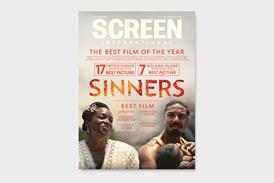











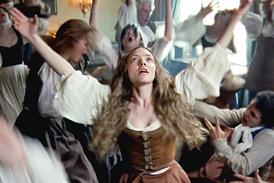

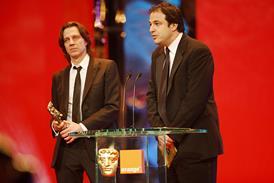







No comments yet